Swiss Drone Regulations

After flying drones in Switzerland for many years, I've developed a deep understanding of the country's unique regulatory landscape. Switzerland's approach to drone regulation balances safety and innovation in a way that reflects the nation's precision-oriented culture. This comprehensive guide explores Swiss drone regulations, compliance strategies, and essential resources based on my extensive experience navigating the Alpine nation's airspace.
Introduction to Swiss Drone Regulations
My first serious drone flight in Switzerland was in 2020, capturing footage in the region of Interlaken. Even then, Switzerland had clearer drone regulations than many European countries, though the system has evolved significantly since. What struck me immediately was the Swiss approach to regulation: logical, well-structured, but with an emphasis on personal responsibility rather than excessive restrictions.
Switzerland's drone regulations serve several important purposes:
- Safety: Preventing conflicts with the country's busy aviation sector, including numerous mountain helicopter operations. I've had to coordinate with helicopter operators in alpine regions multiple times, and the clear regulatory framework made these interactions straightforward.
- Privacy Protection: Addressing Switzerland's strong privacy culture. I've found Swiss citizens to be particularly concerned about drone photography near private property, reflecting cultural values that the regulations acknowledge.
- Environmental Consideration: Protecting wildlife and natural areas. After witnessing the disturbance a drone caused to a chamois herd in the Alps, I gained a deeper appreciation for the environmental aspects of Swiss regulations.
- Noise Management: Minimizing disturbance in a country that values tranquility. The Swiss sensitivity to noise pollution has influenced my equipment choices toward quieter drone systems.
- Federal Structure: Balancing national standards with cantonal and municipal authority. I've learned to research not just federal rules but also local regulations, which can vary significantly between cantons.
Swiss Regulatory Framework
Understanding the multi-layered Swiss regulatory structure has been essential for my operations:
Federal Level: FOCA (Federal Office of Civil Aviation)
- Primary Authority: BAZL/OFAC/FOCA (depending on language region) oversees drone regulations nationally. I've found their guidance materials to be clear and comprehensive, typically available in German, French, Italian, and English.
- Legal Basis: Aviation Act and specific drone ordinances. These provide the foundation for all drone operations in Switzerland.
- EASA Alignment: Switzerland has implemented European Union Aviation Safety Agency (EASA) drone regulations with some Swiss-specific adaptations. As a non-EU member with close ties to the EU, Switzerland has adopted the EASA framework while maintaining some independence in implementation.
Cantonal Level
- Additional Restrictions: Cantons may impose stricter rules than federal regulations. I've encountered significant variations between cantons, particularly regarding nature reserves and wildlife protection areas.
- Enforcement Authority: Cantonal police typically enforce drone regulations. My interactions with cantonal police have generally been positive, with officers knowledgeable about drone rules.
- Local Permits: Some cantons require additional permits for specific areas. I maintain a database of cantonal requirements to streamline my operations across Switzerland.
Municipal Level
- Local Ordinances: Cities and towns may have their own drone restrictions. Zürich, Geneva, and Bern have particularly detailed municipal drone regulations that I've had to navigate.
- Urban Restrictions: Many Swiss cities have specific no-fly zones or permit requirements. I always check municipal websites before urban operations.
- Special Events: Temporary restrictions during festivals, markets, or public gatherings. These are not always well-publicized, requiring direct contact with local authorities.
Drone Categories and Requirements
Switzerland has adopted the EASA drone categorization system with some Swiss-specific implementations:
Open Category
Lower-risk operations without authorization requirements:
A1 Subcategory (Flying "over" people)
- C0 Drones (<250g): Minimal restrictions, may fly near people but not over crowds. My sub-250g drones have been invaluable for certain urban projects where larger drones would be prohibited.
- C1 Drones (<900g): May fly near but not over uninvolved people. I use these for many urban projects where weight and noise restrictions are important considerations.
- Operational Limitations: Maintaining visual line of sight, maximum 120m altitude. These basic limitations apply across all open category operations.
- Pilot Requirements: Online training and exam for drones >250g. I found the Swiss online training to be thorough and informative.
A2 Subcategory (Flying "close to" people)
- C2 Drones (<4kg): May fly at safe distances from uninvolved people (30m or 5m in low-speed mode). Most of my professional work uses drones in this category.
- Pilot Requirements: A2 Certificate of Competency. The Swiss implementation of this requirement includes both theoretical knowledge and practical skill demonstration.
- Technical Requirements: Drones must have low-speed mode and appropriate safety features. These requirements have influenced my equipment choices for Swiss operations.
A3 Subcategory (Flying "far from" people)
- C3/C4 Drones (or drones <25kg without class identification): Must fly far from people and buildings (150m). I use this category for rural and natural landscape projects.
- Pilot Requirements: Online training and exam. The requirements are less stringent than for A2 operations but still ensure basic competency.
- Operational Area: Must be in areas where no uninvolved people are endangered. I carefully scout locations before A3 operations to ensure compliance.
Specific Category
Medium-risk operations requiring authorization:
- Operational Authorization: Required for operations beyond Open category limitations.
- Risk Assessment: SORA (Specific Operations Risk Assessment) methodology. The Swiss implementation of SORA is thorough but navigable with proper preparation.
- Standard Scenarios: Pre-defined operation types with simplified authorization.
- Light UAS Operator Certificate (LUC): For operators with proven safety management system.
Certified Category
Higher-risk operations under rules similar to manned aviation:
- Currently Limited Implementation: Few operations fall under this category in Switzerland at present. This category will become more relevant as drone operations expand into areas like urban air mobility.
- Future Development: Will apply to passenger transport and operations over crowds. Switzerland is positioning itself as a leader in this emerging space, particularly for medical and mountain rescue applications.
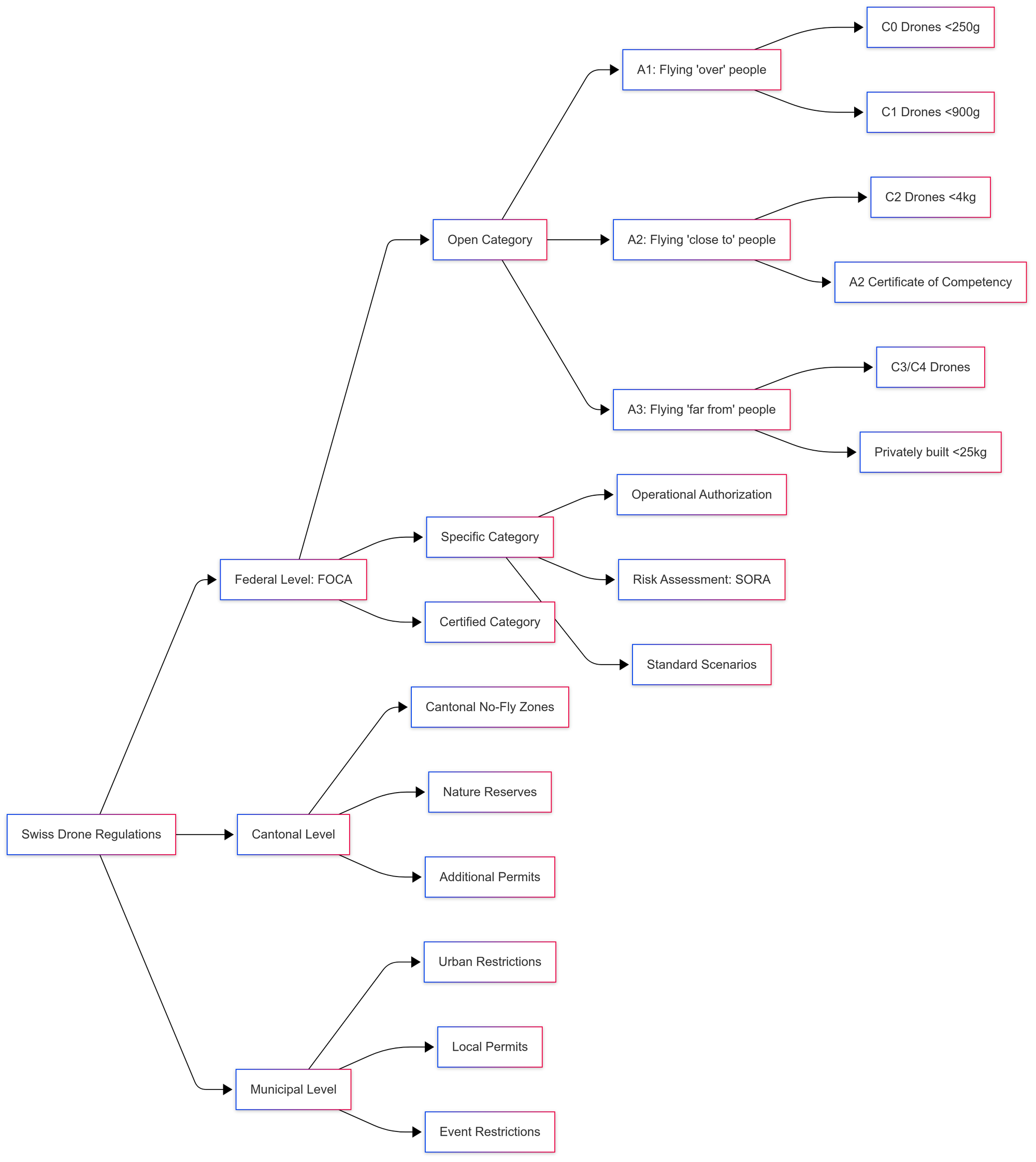
Operational Limitations and No-Fly Zones
Switzerland has specific operational limitations and restricted areas that I've learned to navigate carefully:
General Operational Limitations
- Maximum Altitude: 120m above ground level. In mountainous terrain, this is measured from the closest surface point, which requires careful flight planning in Alpine regions.
- Visual Line of Sight: Must maintain unaided visual contact with the drone. Switzerland's varied terrain can make this challenging—I've developed specific protocols for maintaining VLOS in mountain environments.
- Maximum Weight: 25kg without special authorization.
- Night Operations: Permitted with appropriate lighting. I've conducted numerous night operations in Switzerland, which requires additional risk assessment and lighting considerations.
- Autonomous Flight: Limited to within VLOS unless specifically authorized. I've received special authorizations for certain automated mapping missions, but these require extensive documentation.
Federal No-Fly Zones
- Airports and Heliports: 5km exclusion zone around airports, variable zones around heliports. Switzerland has numerous mountain heliports that aren't always obvious on standard maps—I use aviation charts to identify these.
- Military Areas: Restricted zones around military facilities. These are clearly marked on aviation maps and drone apps.
- Border Areas: Some restrictions within 100m of national borders. I've occasionally needed special coordination for projects near borders.
- Federal Government Buildings: Restricted zones in Bern around federal buildings. These restrictions are particularly strict and enforced vigilantly.
- Nuclear Power Plants: 5km exclusion zones. These are absolute no-fly zones with zero flexibility.
Cantonal and Natural Area Restrictions
- Wildlife Reserves: Numerous protected areas, particularly for birds. These vary by canton and season.
- National Parks: Strict drone prohibition in the Swiss National Park and most nature reserves.
- Cantonal Forests: Many cantons restrict drone use in forest areas, particularly during hunting or breeding seasons. The specific rules vary significantly between cantons.
- Alpine Protected Areas: Special restrictions in certain mountain regions. These are particularly important during wildlife breeding and migration seasons.
Urban and Population Restrictions
- Crowd Restrictions: Prohibition on flights over gatherings of people. This requires careful planning for urban operations and events.
- Urban Centers: Many Swiss cities have specific drone restrictions or permit requirements. Zürich, Geneva, and Bern have particularly comprehensive urban drone regulations.
- Privacy Considerations: Strong restrictions near private properties. Swiss privacy culture is particularly sensitive, and regulations reflect this.
- Temporary Restrictions: Events, emergencies, VIP movements. These can appear with little notice and override normal permissions.
Practical Approach to Restrictions
My approach to navigating these restrictions:
- Multiple Information Sources: I cross-reference official FOCA information with cantonal websites and specialized apps. No single source contains all restrictions.
- Direct Communication: For uncertain areas, I contact cantonal authorities directly. Email confirmation of permissions has resolved several potential issues during operations.
- Seasonal Awareness: Many natural area restrictions in Switzerland are seasonal. I maintain a calendar of seasonal restrictions affecting my common operating areas.
- Local Knowledge: Working with local guides or contacts in unfamiliar areas. Local knowledge has proven invaluable, particularly in mountain regions with complex restrictions.
| Restriction Type | Distance/Limitation | My Practical Approach |
|---|---|---|
| Airports | 5km | Use FOCA maps and apps to identify. Contact tower for operations between 3-5km |
| Heliports | Variable (typically 2-3km) | Identify using aviation charts, not just standard maps |
| Crowds | No overflight | Define clear lateral boundaries during event operations |
| Nature Reserves | Complete prohibition in most cases | Research specific reserve regulations, as some allow limited drone use |
| Urban Centers | Varies by municipality | Contact municipal authorities directly for current requirements |
| National Borders | 100m in some areas | Add buffer zone of 150m to ensure compliance |
| Maximum Altitude | 120m AGL | In mountains, use terrain-aware planning to maintain legal height |
| VLOS Requirement | Unaided visual contact | Use spotters in complex terrain (documented in operation manual) |
Key Swiss drone restrictions and my practical approaches to compliance based on years of operation throughout Switzerland.
Registration and Identification Requirements
Switzerland has implemented registration requirements aligned with EASA standards but with some Swiss-specific elements:
Operator Registration
- Registration Requirement: Mandatory for operators of drones >250g or with cameras/sensors (regardless of weight). I registered immediately when the system was implemented and update my information annually.
- Registration Process: Online through FOCA's drone portal. The Swiss system is efficient and user-friendly compared to many other countries.
- Registration Number: Format CH-RP-XXXXXX. I display this on all my drones using standardized labels.
- Age Requirement: Minimum 12 years old (with guardian consent if under 18). For professional operations, additional age requirements may apply depending on the operation category.
- Renewal: Regular renewal required. I maintain calendar reminders to ensure timely renewal.

Drone Identification
- Physical Marking: Registration number must be displayed on the drone. I use fireproof labels that include both my Swiss and EU registration numbers.
- Electronic Identification: Remote ID requirements being phased in following EASA timeline. I've already upgraded my primary drones to comply with these emerging requirements.
- Documentation Requirement: Carrying proof of registration during operations. I keep digital and physical copies of all my documentation organized by regulatory region.
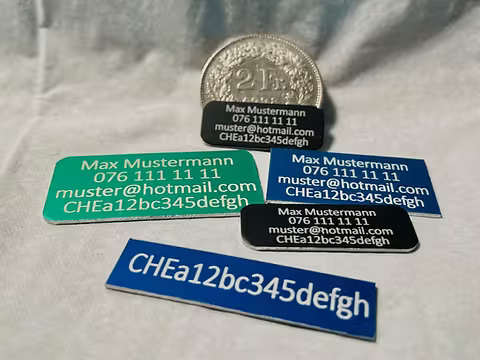
Practical Implementation
My approach to registration compliance:
- Standardized Labeling System: Consistent placement and format across all drones. This simplifies inspections and demonstrates professional compliance.
- Documentation Package: Comprehensive digital and physical documentation. My standard field kit includes laminated copies of all registrations and certifications.
- Cross-Border Considerations: Maintaining both Swiss and EU registrations for cross-border operations. As a non-EU member, Switzerland requires separate registration from EU countries, which is important for my operations that frequently cross into France, Germany, Italy, or Austria.
Insurance Requirements
Switzerland has specific insurance requirements for drone operations that reflect the country's risk-conscious culture:
Liability Insurance
- Mandatory Requirement: Minimum 1 million CHF liability coverage for all drones >500g. I maintain significantly higher coverage (5 million CHF) for my professional operations.
- Documentation: Proof of insurance must be available during operations. I carry standardized insurance certificates in both digital and physical formats.
- Drone-Specific Coverage: General liability policies are usually insufficient. My insurance specifically mentions drone operations and covers all Swiss cantons.
Insurance Considerations
Based on my experience with insurance claims and requirements:
- Cross-Border Coverage: Ensuring coverage extends to neighboring countries. My policy covers all of Europe, which is essential for my cross-border operations.
- Commercial vs. Recreational: Different requirements and considerations. My commercial policy includes additional protections specific to professional operations.
- Cantonal Variations: Some cantons may have additional insurance requirements. I verify these for each project location.
- Specific Category Operations: Higher coverage typically required. For my Specific category operations, I maintain 10 million CHF in coverage.
Special Permissions and Authorizations
For operations beyond standard limitations, Switzerland has specific authorization processes:
FOCA Authorizations
- Beyond Visual Line of Sight (BVLOS): Special authorization process. I've obtained several BVLOS authorizations for specific projects, particularly in Alpine regions.
- Operations Near Airports: Authorization from air traffic control. Since I live close to an airport, I am very familiar with the procecss: it is pretty straightforward but requires advance planning - typically allow 3-4 weeks for these authorizations.
- Specific Category Operations: Risk-based authorization process. The Swiss implementation of SORA is thorough but navigable with proper preparation.
- Drone Swarms: Special authorization required.
Cantonal and Municipal Permits
- Urban Operation Permits: Required in many Swiss cities. Zürich, Geneva, and Bern have particularly structured permit processes that I've navigated numerous times.
- Nature Area Permits: Special permissions for protected areas. These are handled at the cantonal level and can be challenging to obtain.
- Event Coverage: Coordination with event organizers and local authorities.
Practical Authorization Strategies
My approach to obtaining special permissions:
- Comprehensive Documentation: Detailed operation plans, risk assessments, and mitigation strategies. The quality of documentation significantly impacts authorization success.
- Relationship Building: Establishing professional relationships with regulatory authorities. I've found that demonstrating professionalism and safety consciousness makes a significant difference in the authorization process.
- Timeline Management: Allowing adequate time for authorization processes. I typically begin the process 4-8 weeks before planned operations, depending on complexity.
- Local Partnerships: Working with local drone operators or organizations when needed. For complex projects in unfamiliar regions, local partnerships have proven invaluable.
Tools for Navigating Swiss Regulations
Several tools have proven invaluable for navigating Switzerland's multi-layered drone regulations:
Official Resources
FOCA Drone Website
Comprehensive information on federal regulations. I check this regularly for regulatory updates and new guidance materials.

FOCA Drone Map
Official map of federal no-fly zones. This is my primary reference for federal restrictions, though it doesn't include all cantonal and municipal restrictions.

Cantonal Websites
Information on regional restrictions. I maintain bookmarks for all cantonal drone information pages for quick reference.
Mobile Applications
TCS Drohnen App
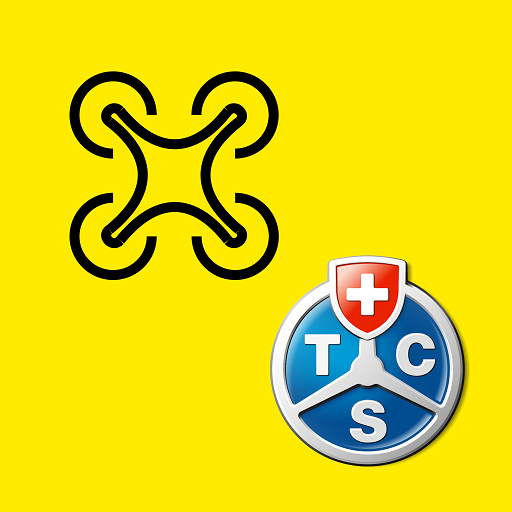
Comprehensive map of no-fly zones, including federal, cantonal, and many municipal restrictions. The integration of multiple regulatory layers makes this particularly valuable in Switzerland's federal system.
Weather information, checklists, and regulatory guidance. The pre-flight checklist feature has become part of my standard operation procedure.
I've used the TCS Drohnen App throughout Switzerland and found it to be the most comprehensive single source for Swiss flight restrictions. The offline functionality has been particularly useful in remote Alpine regions.
Swiss U-Space
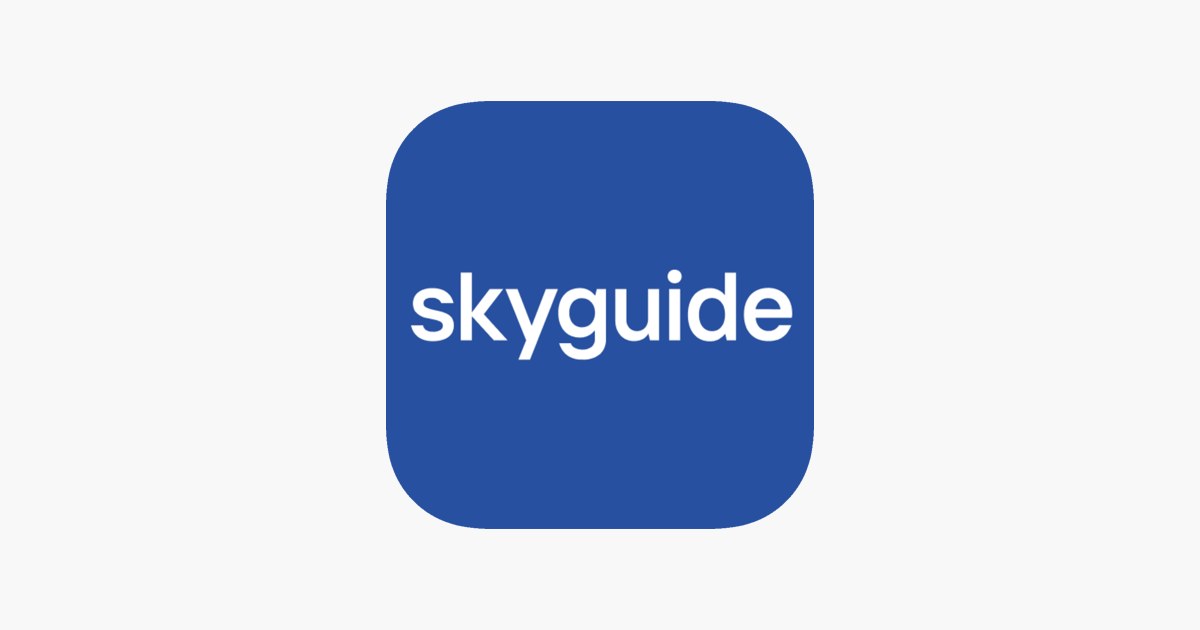
Obtaining clearances for drone operations in the airspace in which Air Traffic Control (ATC) approval is required, including airspace around airports and regional aerodromes.
Other Useful Apps
MeteoSwiss

Swiss weather service app. Essential for Switzerland's highly variable mountain weather conditions.
SwissMap Mobile
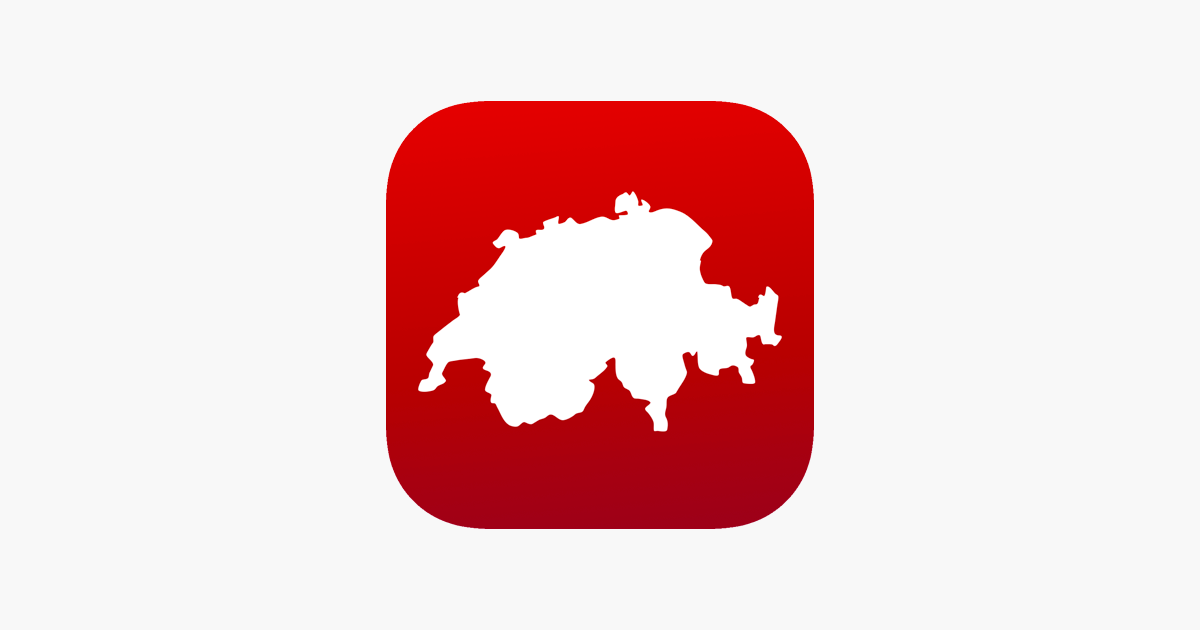
Detailed topographic maps. Invaluable for flight planning in mountainous terrain.
Future Trends in Swiss Drone Regulation
Based on my involvement with regulatory development and discussions with Swiss aviation authorities, here's where I see Swiss drone regulations heading:
U-Space Implementation
- Swiss U-Space: Switzerland is at the forefront of developing unmanned traffic management systems. I've participated in several U-Space trials and am optimistic about how this will transform operations.
- Integration Timeline: Phased implementation over the next 3-5 years. The Swiss approach is methodical but progressive.
- Operational Impact: Will eventually enable expanded BVLOS operations and urban drone services. This will significantly expand the operational possibilities for professional operators.
Expanded BVLOS Operations
- Medical Deliveries: Switzerland is pioneering drone medical transport. The mountainous terrain makes drone delivery particularly valuable for medical applications.
- Infrastructure Inspection: Expanded authorizations for power line and railway inspections. These applications are particularly relevant in Switzerland's complex terrain.
- Alpine Search and Rescue: Development of specialized frameworks for mountain rescue operations. Switzerland's mountain rescue organizations are increasingly incorporating drones into their operations.
Noise Regulation Development
- Noise Certification Standards: Development of specific noise limitations. Switzerland's sensitivity to noise pollution is likely to result in more structured noise regulations.
- Urban Operation Noise Limits: Specific standards for operations near populated areas. This may influence equipment choices for urban operations.
- Cantonal Variations: Likely development of canton-specific noise regulations. This would align with Switzerland's federal approach to environmental regulations.
Privacy Framework Evolution
- Integration with Data Protection Laws: More specific guidelines on drone-based data collection. Switzerland's strong privacy culture will likely influence these developments.
- Operational Requirements: Potential development of privacy impact assessments for certain operations. I've already begun implementing these voluntarily for sensitive operations.
- Public Notification Systems: Possible requirements for notifying the public of drone operations. Some cantons are already moving in this direction.
Pro Tips for Flying in Switzerland
After years of flying throughout Switzerland, here are some of my hard-earned insights:
- Respect Local Sensitivities: Swiss citizens generally value privacy and tranquility. I make a point of informing nearby people about my flight intentions and purpose, which has transformed potentially hostile encounters into curious and supportive interactions.
- Mountain Flying Considerations: Alpine conditions create unique challenges. I always allow for rapidly changing weather and carry additional batteries to compensate for reduced flight times at higher altitudes.
- Language Preparation: Having permit documentation in the local language (German, French, or Italian, depending on the region). I maintain templates in all three languages to streamline communication with local authorities.
- Seasonal Awareness: Many natural area restrictions in Switzerland are seasonal. I maintain a calendar of seasonal restrictions affecting my common operating areas, particularly for wildlife protection.
- Cantonal Variations: Never assume regulations are identical between cantons. I've encountered significant differences in interpretation and implementation between neighboring cantons.
- Professional Presentation: Maintaining a professional appearance and operation style. I've found that demonstrating professionalism significantly impacts interactions with authorities and the public.
- Insurance Verification: Confirming that insurance explicitly covers the specific canton of operation. Some insurance policies have exclusions for certain regions or types of operations.
- Local Partnerships: Developing relationships with local drone communities. These connections have provided valuable insights into unwritten local practices and expectations.
- Documentation Redundancy: Maintaining both digital and physical copies of all permits and authorizations. I've encountered situations where physical documentation was specifically requested.
- Weather Margins: Building extra weather contingency into Swiss operations. The mountainous terrain can create highly localized weather conditions that aren't always accurately forecast.
FAQ: Common Questions About Swiss Drone Regulations
How do Swiss regulations differ from EU regulations?
Based on my experience operating under both systems:
- EASA Alignment: Switzerland has largely adopted the EASA framework but with some Swiss-specific implementations. The core categorization (Open, Specific, Certified) is identical.
- Federal Structure: Switzerland's cantonal system creates an additional regulatory layer not present in most EU countries. This means checking not just national but also cantonal and sometimes municipal regulations.
- Implementation Timeline: Switzerland sometimes implements changes on a different timeline than EU member states. I've found that Switzerland often implements new safety requirements promptly but may extend transition periods for administrative changes.
- Non-EU Status: Separate registration required despite EASA alignment. As a drone professional operating in both Switzerland and the EU, I maintain separate registrations.
- Insurance Requirements: Switzerland's minimum insurance requirements are sometimes higher than neighboring countries. My Swiss insurance coverage exceeds the requirements of all surrounding countries.
What are the most common regulatory mistakes by drone pilots in Switzerland?
Based on my observations and discussions with authorities:
- Overlooking Cantonal Regulations: Assuming federal rules are comprehensive. I've met many pilots who were unaware of cantonal restrictions until encountering enforcement.
- Nature Reserve Violations: Flying in protected areas, particularly wildlife sanctuaries. These restrictions are not always obvious on general maps but are strictly enforced.
- Airport Proximity: Underestimating the size of airport exclusion zones. The 5km restriction around airports catches many recreational pilots by surprise.
- Insurance Gaps: Inadequate or non-drone-specific insurance coverage. General liability policies often exclude drone operations.
- Altitude Violations: Exceeding 120m, particularly in mountainous areas. The requirement to measure from the closest surface point is sometimes misunderstood in Alpine regions.
- Privacy Violations: Flying too close to private properties. Switzerland's privacy culture is particularly sensitive to perceived surveillance.
How strictly are drone regulations enforced in Switzerland?
Based on my experience and observations:
- Federal Enforcement: Moderate to strong, particularly near airports and critical infrastructure. FOCA takes safety violations seriously, with significant penalties possible.
- Cantonal Variation: Enforcement varies significantly between cantons. Urban cantons like Zürich and Geneva typically have more active enforcement than rural areas.
- Focus Areas: Particular emphasis on nature reserves, airport zones, and privacy violations. These are the areas where I've most commonly observed enforcement actions.
- Enforcement Approach: Generally educational rather than punitive for minor, first-time violations. My interactions with enforcement officials have been professional and focused on compliance rather than penalties.
- Public Reporting: Active citizen reporting of perceived violations. I've found that Swiss citizens are more likely to report drone operations they consider problematic than in many other countries.
What insurance do I need for flying in Switzerland?
Insurance requirements and considerations:
- Legal Minimum: 1 million CHF liability coverage for drones >500g. This is the absolute minimum—I recommend higher coverage for any serious operation.
- Professional Operations: Higher coverage advisable (3-10 million CHF). My professional operations maintain 5 million CHF coverage as standard, with higher limits for specific projects.
- Drone-Specific Policy: Must explicitly cover drone operations. General liability or hobby insurance is typically insufficient.
- Cross-Border Considerations: Coverage should include neighboring countries if operating near borders. My policy covers all of Europe, which is essential for my cross-border operations.
- Proof of Insurance: Documentation should be carried during all operations. I maintain both digital and physical copies of my insurance certificates.
How do I get permission to fly in Swiss cities?
Based on my experience with urban operations throughout Switzerland:
- Municipal Permits: Many Swiss cities require specific permits. The application process varies significantly between municipalities.
- Application Timeline: Typically 2-4 weeks advance application. I allow at least 3 weeks for standard urban permits and longer for complex operations.
- Documentation Required: Operation details, flight area, purpose, dates/times, pilot credentials, and insurance proof. More complex operations may require comprehensive risk assessments.
- Local Coordination: May need coordination with local police or security services. For larger operations, I typically conduct a pre-operation briefing with local authorities.
- City-Specific Approaches:
- Zürich: Structured online application process through the city website
- Geneva: Application through cantonal police with municipal coordination
- Bern: Application through city administration with special considerations for federal areas
- Basel: Coordinated process between city and cantonal authorities
How do seasonal restrictions affect drone flying in Switzerland?
Switzerland has numerous seasonal wildlife protections:
- Wildlife Breeding Seasons: Expanded restrictions in many natural areas, particularly February-July. These affect many mountain and forest areas popular with drone operators.
- Bird Migration Periods: Additional restrictions in certain areas during spring and autumn migrations. These are particularly strict in designated bird sanctuaries.
- Winter Wildlife Protection: Special restrictions in some Alpine regions during winter. These protect wildlife during vulnerable winter months when their energy reserves are limited.
- Hunting Seasons: Some cantons restrict drone use during hunting seasons. This varies significantly between cantons.
- Information Sources: Cantonal wildlife office websites provide the most current information. I check these seasonally for areas where I frequently operate.
Conclusion
Flying drones in Switzerland presents a unique regulatory landscape that balances clear national framework with cantonal and municipal variations. While this multi-layered approach can initially seem complex, I've found that the Swiss system ultimately provides a logical and reasonable framework for safe drone operations once understood.
The Swiss approach emphasizes personal responsibility and risk assessment rather than blanket prohibitions. This aligns with the country's broader regulatory philosophy and creates an environment where professional drone operations can thrive while maintaining high safety standards.
Switzerland's position at the forefront of drone innovation—particularly in areas like medical delivery, Alpine search and rescue, and U-Space development—makes it an exciting environment for professional drone operations. The regulatory framework continues to evolve to accommodate these innovations while maintaining Switzerland's characteristically high safety standards.
Whether you're flying recreationally in the spectacular Swiss landscape or conducting professional operations, understanding and respecting the multi-layered regulatory structure is essential. The effort invested in proper research and compliance pays dividends in operational freedom and contributes to the sustainable growth of drone operations in Switzerland.
References and Further Reading
- Long-Range Flying and Extended FPV Drone Operations
- Drone Regulations Worldwide: A Guide to Flying Legally
External Resources
- FOCA Drone Information - Federal Office of Civil Aviation drone resources
- TCS Drohnen App - Essential Swiss drone app with comprehensive restriction information
- Drone-Made Swiss Regulations - Practical guide to Swiss drone regulations
- DroneMaps24 - Global drone regulations resource including Swiss information
- Swiss U-Space - Information on Switzerland's unmanned traffic management and online application for airspace use
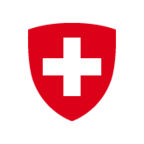
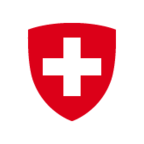





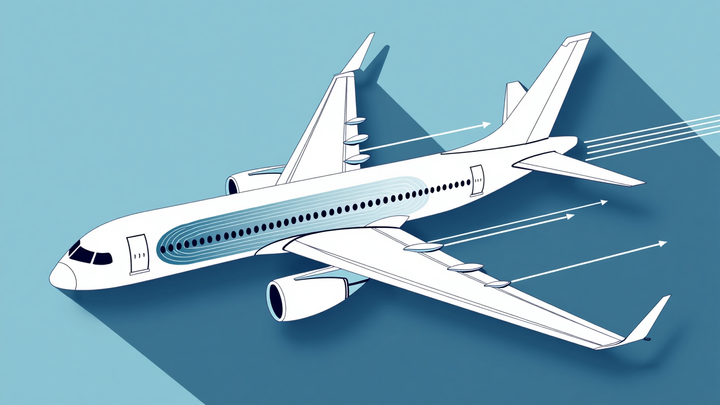

Comments ()